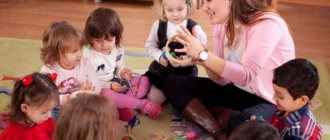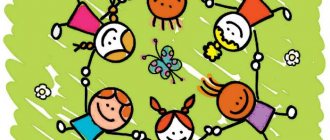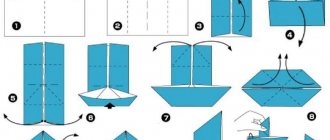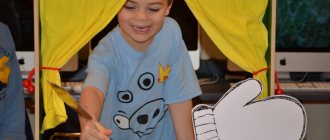“What a wonderful baby, are you already going to kindergarten?” - this phrase in the modern world can be officially recognized as an introductory phrase for meeting mothers on the playground.
Further, the conversation will most likely develop in two planes: “we don’t plan to send the child to kindergarten at all” or “socialization is important for the child, we are waiting for a state kindergarten, but for now we are going to a private one.”
And it cannot be said with certainty that this family is doing the right thing by categorically opposing the kindergarten, and the other is not. It all depends on the individual child and his parents.
In this article we will try to answer the question of whether it is worth sending your child to kindergarten, and consider all the pros and cons.
What documents are needed for kindergarten?
In Russia, to admit a child to kindergarten you will need:
- Identity documents of parents
- Referral (voucher) to the commission about placing a child in kindergarten
- Application addressed to the head of the kindergarten for admission of a child to the kindergarten
- A copy of the mandatory insurance policy
- Copy of the child's birth certificate (show the original)
- Child's medical record form No. 026
- Preventive vaccination card form No. 063
- A certificate from a pediatrician stating that the child is healthy and has not had contact with infectious patients. The certificate is valid for 3 days
- If you have payment benefits, then supporting documents
- If a child requires a special speech therapy group, then a medical certificate confirming the need to attend such a group
- If a child is allergic to foods given in the garden, then a medical certificate from an allergist confirming the presence of an allergy
Which children are better off staying at home?
There is such a thing as a “non-kindergarten child”. These are children who just can’t get used to their “second home.” They painfully part with their mother, sobbing and clutching her leg, do not join in the games of their peers, keep to themselves, they cannot get used to the daily routine.
The process of adaptation to kindergarten for such children never ends. And even after several years, the kindergarten seems something terrible to them.
Non-kindergarten children, even if they do not clearly show their dissatisfaction, begin to show it in a different way: often get sick, have trouble sleeping, in some cases nocturnal enuresis appears, the child withdraws into himself and “does not come to life” even at home.
But the percentage of “non-kindergarten children” is small, and many problems are solved with the help of a child psychologist.
There are also children for whom kindergarten is not recommended for health reasons. Such children require individual care, a special regime and activities that a state kindergarten cannot provide them with.
What kind of doctors do I need to see for kindergarten?
- Therapist. This is the first doctor you and your child should visit. He assesses the child’s general condition, gives referrals to the following doctors and, based on the results of the commission, issues a certificate of the required form.
- Otolaryngologist. ENT identifies the most common nasopharyngeal problems in children: adenoids, tonsillitis, deviated nasal septum. If these problems are detected, the doctor makes a decision on treatment
- Ophthalmologist. As a rule, the examination is aimed at identifying the following problems: far- or myopia, strabismus. If they are detected, treatment is prescribed
- Neurologist. Tries to find out at the appointment whether there are neurological abnormalities: hits the knee with a hammer, checks the vestibular system and coordination
- Surgeon. Looks at the condition of the spine, feet, posture. If necessary, gives recommendations or prescribes treatment. Also examines boys' foreskin and testicles
- Dentist. Identifies problems with a child's teeth, such as early childhood caries. Be sure to examine the frenulum and check the bite
- Speech therapist. For children under 3 years of age, the speech therapist only gives recommendations if they have some speech characteristics, since up to 3 years of age speech is still being established. After 3 years, in order to avoid more serious speech defects, the doctor gives a referral to a speech therapy group in the garden or strongly recommends taking a course of treatment from a speech therapist
IMPORTANT: If you see that the doctor examined your child rather superficially, ask for a more careful approach. This is especially true in cases where you yourself suspect that something is wrong.
What should a child buy for kindergarten?
- Clothing (read more below)
- Package with a change of clothes
- Stationery (read more below)
- Clothes for the pool, if available (read more below)
- Eating bib
- Bag for dirty clothes
- Hairbrush for girls
- 2 handkerchiefs
- Hand and foot towel
- Toilet paper
- Napkins
IMPORTANT: Before heading to the store, be sure to ask for a list of what is needed in the kindergarten, so as not to buy too much and, conversely, not to miss anything
Which children are best sent to kindergarten?
If you have a little lively child growing up at home who is interested in everything around him, then he will be fine in kindergarten. It would be useful to determine the type of temperament of the child. Sanguine and choleric children love to be the center of attention, quickly get used to new conditions and usually ask to go to kindergarten themselves.
Yes, they may also have problems adapting to kindergarten at first, but they quickly find friends and become attached to their teachers.
Phlegmatic and melancholic people, on the contrary, adapt more slowly to a new team and may experience difficulties communicating with other children.
And then, if parents work remotely or are constantly busy with their own affairs, then it is better to send the child to kindergarten. There he will not be busy only watching cartoons, but will also receive communication with peers, educational activities, and in the evening he will be able to quench his thirst for communication with his parents.
Shoes for kindergarten
The child always wears shoes in the garden. Change of shoes is recommended. Various incidents can happen to small children. For outdoor wear, choose shoes that suit the weather.
General requirements:
- For a group, buy open sandals or sandals
- Feet should not sweat in the chosen shoes
- Shoes should be comfortable and should not cause discomfort to the child.
- Buy shoes with Velcro at least for children under 4 years old, or until you see the child’s ability to fasten shoes without Velcro
- Don't buy shoes that only have laces. Let there be a lock on the side, otherwise the child will have difficulty putting on shoes.
- For autumn, store rubber boots in your locker
List of stationery
Before purchasing stationery, check whether your kindergarten needs them.
As a rule, you need:
- Sketchbook
- Gouache (6 colors)
- Paint brushes: thin and thick
- Colored paper
- Colored cardboard
- Plasticine
- Sippy cup
- Colour pencils
- Sharpener
- Pencil case
FIND A TOY.
The leader hides a small toy in the group, in one of its rooms, and then invites the others to find it. At first it is not so difficult to find, for example:
“The toy is lying on the windowsill in the reception (locker room). Then more difficult:
“The toy lies in the bedroom, under the pillow on Nadya’s bed.”
After the toy is found, it must be said what it was doing there (going for a walk, sleeping...)
Later, you can guess the location of the toy in a different way: through the function of the room (“Washes the dishes”), through its actions (“Lies quietly, eyes closed”).
Having mastered the group, you can move on to a closer acquaintance with the kindergarten and its employees. It’s better to start with excursions around the garden (it’s more advisable to organize thematic excursions: to the kitchen, to the medical office), and get to know the people working there.
What does a child need for a swimming pool in the garden?
IMPORTANT: Requirements for things for the pool may differ in gardens, so first check with the teacher about this point.
List of what you need:
- Pool cap on your head. This is done for hygiene purposes. The rubber one will be more uncomfortable for the child, but often this is what is required in the pool. Even though a rag hat will wet your hair, it will be more pleasant for your child to wear such a hat.
- Rubber slippers. Crocs have proven themselves well: a child’s foot won’t slip out in them
- Shower accessories: washcloth, soap
- Large towel
- A robe to take from the shower to the pool
- Swimsuit/swimming trunks
Psychological preparation of a child for kindergarten
Psychological preparation of a child for kindergarten is a very painstaking and sometimes very difficult process. Some children feel confident and calm from the first day in kindergarten. And some, after a month, don’t want to stay there for more than two hours. It depends on the child’s character, his confidence and fears.
Differences in temperament.
- Melancholic. Such a child always demands that his whims be fulfilled, does not tolerate refusals, does not like new people, freaks out over little things, throws hysterics, is withdrawn, does not want to communicate with anyone except his family, and constantly demands attention. Of course, such a child will not want to go to kindergarten. You will have to endure his tantrums and screams
- In the garden, a child can behave aggressively, since he is still forced to be there. He will have problems with friendships. It is difficult to persuade such a child to go to kindergarten, but it is still worth trying. Tactics: do not force and, especially, do not force
- With such a child, be prepared that adaptation will be delayed, and the return to work may be delayed. There will be no point in forcing such a child into kindergarten: he will become a hooligan or simply be sad in the corner
- Find the advantages of visiting the garden that may interest your child: for example, the fact that there will be new toys there. Or look for a compromise: the child goes to kindergarten, and then you will buy him a new toy every weekend. The optimal age for sending such children to kindergarten is 5 years old
- Phlegmatic person. This is a calm child who does not cause problems. He knows how to play alone. But he doesn’t adapt well to the garden, because he wants to go to his home with his mother. In the garden, such children do not cry, but they do not have fun either. They spend the day sadly waiting for their mother to come
- Parents' tactics: encourage the child, if possible, give him a favorite toy in the garden that he can put in the closet, or donate bedding from home. So, the baby will feel more comfortable and cozy
- Choleric. These are active children who love to fool around, run, jump and attract attention. Such children love to be the center of attention, so they will organize peculiar groups of naughty people in the garden
- Such children cause a lot of trouble for educators with their not always useful, but irrepressible energy. Parents' tactics: there is no point in trying to suppress activity in a child, it just needs to be directed in the right direction. The best age for adaptation is 3-4 years
- Sanguine. This is an active child who loves communication and new experiences. He will happily go to the garden, talk to the children, and play all the games. But as soon as the games become boring, the child will stop wanting to visit the kindergarten
- Such children should be sent to kindergarten earlier than others, but choose a kindergarten where the children are not left to their own devices, but where they will be entertained with new activities every time. Then you will not see problems with your child’s adaptation to kindergarten
GAMES WITH CHILDREN INDOORcard file (senior group) on the topic
PLAYING WITH CHILDREN INDOOR
Living - non-living
The presenter names living and inanimate objects mixed together, and the children answer in chorus only “living”, and are silent when they answer “inanimate”. The children who make the fewest mistakes win.
Line
Children line up in one line in the direction of the leader's hand. When he speaks in all directions, everyone runs away. And when they heard the chant: “The guys have strict order, tra-ta-ta, tra-ta-ta, they know all their places,” they run and line up in a new direction. The latter is considered the loser.
Find the color
Children stand in a circle and, at the leader’s command, look for objects of the named color in order to touch them. The loser is the one who touches the desired thing last. He is out of the game.
Predator
All children are fish, one of them is a predator. When an adult shouts: “Ship,” the fish take cover against one wall, when they shout “Storm,” they take cover at the other, and when the word “predator” is heard, they begin to flee, while the predator reveals itself and begins to catch them.
Sunny bunnies
This activity is suitable for sunny weather. You should take a small mirror, let sunbeams onto the walls and ceiling and watch them together with your baby.
Runners are jumping - Sunny bunnies. We call them, but they don’t come. They were here - and they are not here. Jump, jump around the corners. They were there - and they are not there. Where are the bunnies? Gone. Haven't you found them anywhere? (A. Brodsky)
Listen
The leader whistles, signaling the blindfolded players and changing their direction. Focusing on the sounds, you need to find an adult.
Items
Children bring some small objects with them and put them in one place. Next, choose one of the players to stand with his back to the objects. The presenter, pointing to one of the items, asks: “What should the person who owns this item do?” All players see this object, but one has his back to it and does not know whose object the leader is pointing to. This player's job is to assign "fines", a task that the owner of the item must complete in order to redeem the item.
Through the hoop
The player holds a racket with a table tennis ball in one hand, and a gymnastic hoop in the other. The player’s task is to pass the hoop through himself from top to bottom, then from bottom to top, without dropping the ball. They play in pairs. The one who completes the task faster wins.
Arithmetic cubes
To play you need 3 dice. Everyone throws them 3 times. If among the dropped numbers there are identical ones, they are added up (for example, 3, 5 and 3 are dropped, playing the sum 3+3=6, and if all different numbers are dropped, say 5, 2 and 3, they are not taken into account). If it happens that after the next throw all 3 numbers turn out to be the same (for example, 4,4 and 4), then the sum of these numbers also doubles. The winner is the one who, after three throws, ends up with the largest sum of numbers.
Clothespins
Players need to find and collect all the clothespins in the room. Clothespins can be different: plastic, wooden, colored, transparent, old, new. The main principle: the more, the better. The players are divided into pairs. The couple is given a headband with clothespins. The task is very simple. One child blindfolds himself. Clothes pins are attached to the partner's clothes. Moreover, those around them hang up the clothespins, not the child himself. Where to attach them is up to them to decide. The player has no right to interfere in the process. Next comes the time for the player to act blindfolded. His task is to find and remove all the clothespins from the player as quickly as possible.
Funny pictures
A game for developing visual memory. Invite your child to carefully look at 10 pictures, each of which depicts a familiar object. Then ask your child to name the items he remembers one by one. The number of items that the child remembers is important. Show your child pictures that he did not name. Please try again in 10 minutes. Offer to remember all the pictures in an hour.
Get the town
Participants in the game take a toes-and-fives stance, with their hands clasped behind their backs (the hand of one hand grabs the wrist of the other). When squatting, he must, without moving from his place and without touching the floor with his hands, lift the town (puck, cube, cone, etc.) located behind his leg. The winner is the one who succeeds the most times out of three attempts.
Find the bunny
To play you will need a clean handkerchief. You should take it by its 2 adjacent ends, look behind it on both sides and ask: “Where is our bunny? Where did he run off to?" After this, you need to tie the ends of the scarf into knots so that they look like bunny ears, and say: “Here comes the bunny! Where is his tail? At the remaining end of the scarf you need to tie a small knot-tail: “And here is the tail! Let's pet him."
gold fish
The child is a goldfish who offers the fisherman his wish. You come up with something supernatural, and he must find a good reason why he cannot fulfill your desire. Then you can switch roles.
Damaged fax
Participants sit in a row one after another. The last participant draws a picture on the back of the person sitting in front of him. The player who receives the message must repeat it as accurately as possible on the back of the person sitting in front. The first player in the row, having received the message, draws it on paper. After this, the drawings of the first and last players are compared and it is revealed which participants in the game the fax failed on. Before the next round, all players must change places.
Geometric shapes, letters and small words, various symbols (dollar sign, euro, ampersand, copyright) can be used as drawings.
It is advisable to start the game with simple geometric pictures. To make the game more dynamic, you can prepare drawings for transmission in advance, secretly from the participants in the game.
You can play a team version of the game - all participants are divided into teams of 5-8 people and simultaneously submit a drawing. The winning team is the one whose resulting drawing is closest to the original one.
Musical chairs
After the music stops, sit on a chair as quickly as possible. The one who did it last or who did not have enough chairs loses.
Loaches
The players stand in a circle and raise their arms up, forming a “collar”. The host declares the two players standing next to each other to be loaches. One loach stands in a circle and is called “escaping”, the other behind the circle is called “catching up”. The running distance is small - you need to run around the circle once and take your place, but you will have to run not in a straight line, but along a winding line, slipping into the “gate” from one side or the other.
At the leader’s signal, both loaches take off. If he wins, that is, the one running away has reached his place earlier, then a loach is appointed instead, and the one who is catching up remains the same. If the one catching up with the escaping one, then the one catching up chooses a replacement, and the escaping loach remains the old one.
The game can be played with a division into two teams, counting everyone standing as the first and second numbers, then the escaping and catching loaches are selected from different teams, and the success of one or the other brings one point to his team.
Dwarfs - Giants
Children stand waist-deep in water. The presenter gives the signal by shouting the word: “Dwarfs!” Everyone sits in the water. Behind the signal: “Giants!” - all players jump up. The one who makes a mistake is out of the game. The one who remains wins.
Extra item
The teacher displays rows of geometric shapes on a typesetting canvas. In each row, one figure differs in color (shape, size). Students must find the “extra” figure and explain why they decided so. For the correct answer, the student receives a chip.
Ball over the line
Players from two teams enter the water and line up at opposite sides of the pool facing the middle. The side is for them in the game the line of the house that they defend. The leader throws the ball into the middle between the teams. The players swim towards him and, having taken possession of the ball, begin to throw it among themselves, trying not to give it to the opponent. The challenge is this. To approach the opponent's house and touch the side of the pool with the ball. On an open reservoir, the playing field is limited by floats and paths of floats. The game lasts 10 minutes. The team that manages to touch the opponent's house with the ball the most times wins.
Hurry up to pick
A participant stands in a circle with a diameter of 1 meter with a volleyball in his hands. There are 8 tennis (rubber) balls behind the player. At a signal, the participant throws the ball up, and while it is in the air, he tries to pick up as many balls as possible and, without leaving the circle, catch the ball. The participant who managed to pick up more balls wins.
Monkey tag
Monkey tag is a type of tag. The driver catches up with the runner, who is changing his methods of movement; the driver is obliged to change his method of movement after the runner.
Chain fishing
Chain fishing is a type of tag. The beginning is like a game of fishing in pairs, only the drivers remain in one chain. This game takes place interestingly in the forest or among the pillars.
Freeze in place
To conduct the game, one or more participants are appointed to play the role of sorcerers. The one who is touched by the sorcerer must stop in place and spread his legs apart. The player can continue the game if one of the runners crawls between his feet.
Flying Dutchman
This game is best played in the forest, especially if everyone is frozen. They will warm up very quickly. Players (10-30 people) stand in a circle and join hands. One pair of people runs in a circle. Suddenly one of them hits the clasped hands of someone in the circle. The couple that was hit must jump out of the circle and run around it, the couple that hit does the same, only they run in the opposite direction. The two who run around the circle faster take up the empty space. Others remain running around in circles. History repeats itself.
Falling stick
Standing in a circle, several players settle down in numerical order. Participant number 1 takes a gymnastic stick and goes to the middle of the circle. Having placed the stick vertically and covering it with his palm on top, he loudly calls a number, for example 3, and he runs back to his place. The one who is named runs forward, trying to catch the falling stick. If he manages to do this, then participant number 1 again takes the stick and, placing it vertically, calls out a number, etc. If the stick falls to the ground, then the one who failed to pick it up becomes the driver. The game lasts 5 - 7 minutes. The winner is the one who played the role of leader less than others.
The last word
The presenter names different nouns. Suddenly he breaks off, approaches one of the children and asks him to repeat the last word. If the child was inattentive and did not remember it, he receives a penalty point. The one with the fewest penalty points wins.
What should a child be able to do for kindergarten?
By the time a child is sent to kindergarten, he must:
- Wean off the pacifier
- Learn to eat with a spoon
- Learn to go potty
- Learn to dress minimally
- Learn to fall asleep relatively independently
To ensure that sending your child to kindergarten does not cause stress for you and your child, prepare for this with all responsibility.








